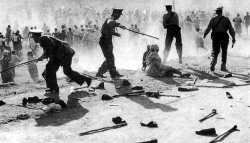
Published date
16 June 1959
Apartheid government efforts to remove Black people from Cato Manor close to the Durban city center to Kwa Mashu, a newly established black township on the outskirts, was met with violent resistance. Cato Manor was home to both Indian and Black people, mostly informal dwellers. Indian people had first begun living there informally at the end of their indentured labour contracts. A small number of them had earned enough money to buy land from White landowners, who were often absentee landlords living in Britain. During the Second World War, increased work opportunities and the relaxation of influx control laws led to Black people streaming into Durban. Thousands of African people moved into Cato Manor as tenants to Indian and African landowners. On 2 June 1946 the government passed the Ghetto Act, aimed at curtailing property ownership of Indian people. A campaign of passive resistance by Indians to this residential segregation law, led the government to placate this group with an offer of limited 'political representation'. Despite the political unity engendered between Africans, Coloureds and Indians through the Passive resistance campaign and the unity of the Indian and African Congress, the outbreak of the "Durban Riots" in 1949 challenged this rapport. It sprang from an incident in which an African youth was allegedly assaulted by an Indian man near Durban's Indian market. A brief period of anti-Indian violence spread across Cato Manor. Indian-owned shops and houses were razed and many Indian residents fled but returned home after the riots had subsided. In the year following this, some Indian landlords who had left Cato Manor continued to come by to collect rent. Some decided to let entire plots to Africans who in turn, sub-let these. In this way 6 000 shacks and 45 000-50 000 people arrived in the area. In 1957 the apartheid spatial division of races further affected living areas. The municipality was instructed to use Cato Manor as a temporary transit camp in the scheme of removals to Kwa Mashu. As it was met with resistance, tensions in Cato Manor worsened. Along with police raids around pass and liquor laws, the situation came to a head in 1959 with widespread rioting and destruction of state property in Durban.
References
'History Cator Manor Development Project', [online], Available at www.cmda.org.za [Accessed: 14 June 2013]|Sahistory., (1959), 'Cato Manor Place and Origins', from South African History Online, [online], Available at www.sahistory.org.za [Accessed: 11 June 2014]